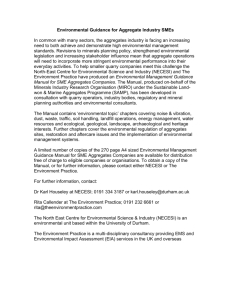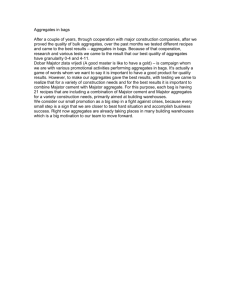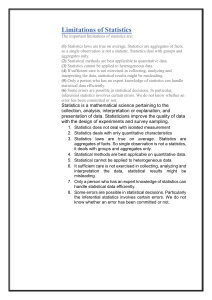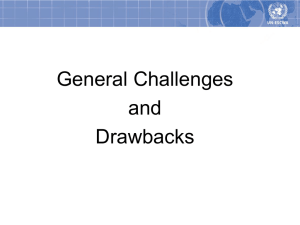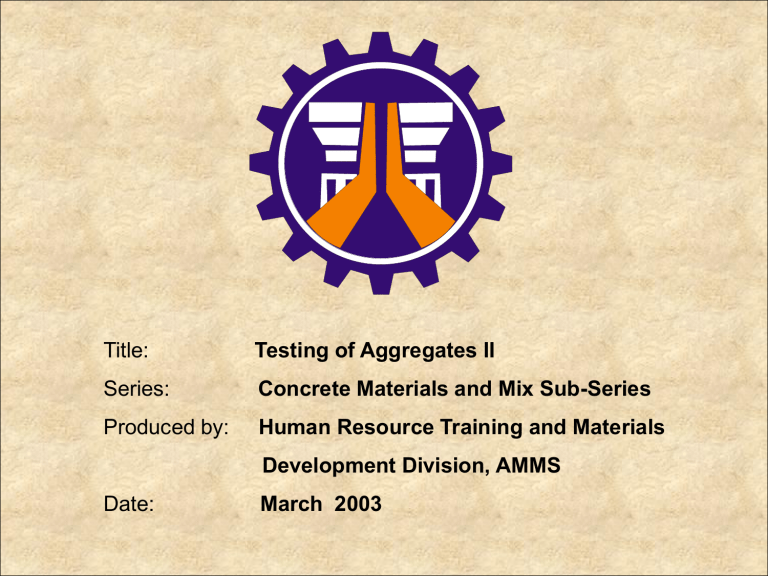
Logo Title: Testing of Aggregates II Series: Concrete Materials and Mix Sub-Series Produced by: Human Resource Training and Materials Development Division, AMMS Date: March 2003 Opening course title PART II * Effect of Organic Impurities in Fine Aggregates on Strength of Mortar * Soundness of Aggregates by use of Sodium Sulfate or Magnesium Sulfate * Unit Weight/Mass Determination of Aggregates * Abrasion of Coarse Aggregates by use of the Los Angeles Machine 4th test : Effect of Organic Impurities in Fine Aggregates EFFECT OF ORGANIC IMPURITIES IN FINE AGGREGATES ON STRENGTH OF MORTAR Determines acceptability of Fine Aggregates Apparatus needed : Flow table Tamper Trowel and molds Water storage Compression machine Cement samples Test procedures: Prepare samples Wash original sample with water Wash sand with Sodium Hydroxide Soak two samples in water Spread sample in flat surface Place sample in mold Prepare water cement ratio Mix the materials Pour sand to cement paste Determine the flow Remove excess mortar Lift mold Drop flow table Place mortar in cube molds Fill the mold Smoothen surface Remove the sample Test for compressive strength Prepare standard mortar Compare compressive strength Age in days 7 7 7 Average Sample 5.1 5.1 5.1 5.1 % of Standard – 100% Standard 5.0 5.1 5.1 5.1 5th test : Soundness of Aggregates SOUNDNESS of AGGREGATES by use of SODIUM SULFATE or MAGNESIUM SULFATE • Determines the aggregate resistance to disintegration by saturated solutions Apparatus needed: Set of sieves Balance Perforated containers Oven Solvents Wash samples Separate fine aggregates PASSING RETAINED (Fine Aggregates) 9.5 4.75 4.75 2.36 2.36 1.18 1.18 0.600 0.600 0.300 1009 1009 1009 1009 1009 Separate coarse aggregates PASSING RETAINED (Coarse Aggregates) 63.5 37.5 37.5 19.0 19.0 9.5 9.5 4.25 30009 15009 10009 3009 Prepare a saturated solution Immerse sample in solution Remove samples Wash with water Pass to original sieve Weigh Formula : Loss in mass Loss in Mass = Mass of test fraction before test MINUS Mass of test fraction after test Formula : Actual % loss Actual % = Loss Loss in Mass Mass of test fraction before test Formula :Corrected % Loss Corrected = % Loss % passing sieve after test Grading of Original sample, % retained 6th test : Unit Weight in Aggregates UNIT WEIGHT or MASS DETERMINATION in AGGREGATES - Determines the unit weight of aggregates in a compacted or Loose condition Apparatus needed: Balance and weights Tamping rod Cylindrical metal measure Shovel Formula : Volume of Container Volume of Container Mass of water = Unit mass of Water at Temperature of Calibration Prepare sample Mass Determination RODDED Unit Weight or Mass Determination Fill 1/3 portion of measure Level and tamp Fill 2nd portion of measure Fill last third portion of measure Remove excess aggregates Weigh container with aggregates Formula : Rodded Unit Weight RODDED UNIT WEIGHT = Net weight of aggregates Volume of the measure Loose Unit Weight Formula : Loose Unit Weight LOOSE UNIT = WEIGHT Net weight of sample Volume of container 7th test : Abrasion of Coarse Aggregates ABRASION of COARSE AGREGGATES BY USE of the LOS ANGELES MACHINE Evaluate the structural strength of course aggregates Apparatus needed : Los Angeles machine Abrasive charges Pans and sieves Balance Oven Test samples Place sample in machine Discharge materials after test Sieve finer portion Wash materials and dry Weigh Formula : % Abrasion Loss a–b x 100 % Abrasion Loss = a where: a= original weight/mass of sample b= weight / mass of Materials coarser than 1.70 mm sieve size Closing course title CONCRETE MATERIALS AND MIX SUB SERIES TESTING OF AGGREGATES Part II The End Logo Produced by Produced by Human Resource Training and Materials Development Division AMMS
